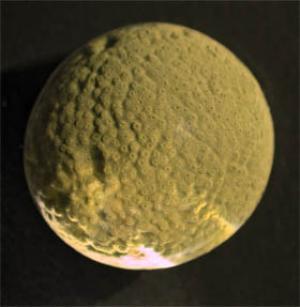
« PREVIOUS ENTRY
In praise of the 3-hour game: My latest Wired News video-game column
NEXT ENTRY »
Apparently NASA is filled with Joss Whedon fans

It’s a single cell, it’s the size of a grape, and it propels itself across the ocean floor: Behold the Bahamian Gromia — one of the strangest beasts yet discovered in the briny deep.
Gromia sphaerica, as the organisms are known, are superbig amoebas, growing up to 1.5 inches in diameter. They were first discovered in 2000 in the Arabian Sea, and have since been found in various locations around the world. Then last year a team of biologists were diving near Little San Salvador Island in the Bahamas, when they discovered a new form of Gromia — the “Bahamian” Gromia, as they’re calling it.
The weird thing is, the Bahamanian Gromia were all found at the end of a trail — as if they’d been somehow pushed or dragged along the seafloor. This didn’t make sense, because the currents at that depth either weren’t strong enough or were irregular, so they wouldn’t push the Gromia in single, uniform paths, the way the trails lay. That left only one possibility: Somehow, these wee blobs are propelling themselves across the ocean floor, at a pace so slow it cannot be readily observed. In a paper published a recent issue of Current Biology — “Giant Deep-Sea Protist Produces Bilaterian-like Traces” (PDF here)— the scientists argue this is precisely what’s happening.
As they said in a press release:
“We watched the video over and over,” Johnsen said. The trails couldn’t be the result of currents because they went in several directions at the same spot, and sometimes they even changed course. And they weren’t the result of rolling downhill. In fact, one trail was found that went down into a small depression and came back up the other side.“We argued about it forever,” Johnsen said. “These things can’t possibly be moving!” But they are, at a rate too slow to be captured on the sub’s video. Johnsen guesses they move maybe an inch a day or less.
Here’s the even crazier thing: If these guys are right, this discovery could completely upend our ideas about the “Cambrian explosion.”
Remember those tracks the Bahamian Gromia left? They’re found in the pre-Cambrian fossil record. For years scientists assumed that only organisms with complex body plans that are symmetrical down the middle — “bilateria,” as they’re called — could possibly move in a fashion that would leave such trails. Thus, biologists have argued that bilateria were around before the Cambrian explosion, which sort of primed the pump for that crazily rapid diversification of bilateria into all the major animal groups we have today. But now it looks as though all those pre-Cambrian seabed trails could have been left by rolling, grape-sized ameobas. Maybe — who knows? — the Cambrian explosion happened even more psychotically quickly than we think. Maybe bilateria weren’t kicking around for millions of years later than we suspect.
The Rolling Grape That Rocked The Fossil Record. As I’ve said before, you can’t make this stuff up, and thankfully you don’t need to.
Check below the jump for pictures of the trails the Bahamian Gromia leave!
I'm Clive Thompson, the author of Smarter Than You Think: How Technology is Changing Our Minds for the Better (Penguin Press). You can order the book now at Amazon, Barnes and Noble, Powells, Indiebound, or through your local bookstore! I'm also a contributing writer for the New York Times Magazine and a columnist for Wired magazine. Email is here or ping me via the antiquated form of AOL IM (pomeranian99).

ECHO
Erik Weissengruber
Vespaboy
Terri Senft
Tom Igoe
El Rey Del Art
Morgan Noel
Maura Johnston
Cori Eckert
Heather Gold
Andrew Hearst
Chris Allbritton
Bret Dawson
Michele Tepper
Sharyn November
Gail Jaitin
Barnaby Marshall
Frankly, I'd Rather Not
The Shifted Librarian
Ryan Bigge
Nick Denton
Howard Sherman's Nuggets
Serial Deviant
Ellen McDermott
Jeff Liu
Marc Kelsey
Chris Shieh
Iron Monkey
Diversions
Rob Toole
Donut Rock City
Ross Judson
Idle Words
J-Walk Blog
The Antic Muse
Tribblescape
Little Things
Jeff Heer
Abstract Dynamics
Snark Market
Plastic Bag
Sensory Impact
Incoming Signals
MemeFirst
MemoryCard
Majikthise
Ludonauts
Boing Boing
Slashdot
Atrios
Smart Mobs
Plastic
Ludology.org
The Feature
Gizmodo
game girl
Mindjack
Techdirt Wireless News
Corante Gaming blog
Corante Social Software blog
ECHO
SciTech Daily
Arts and Letters Daily
Textually.org
BlogPulse
Robots.net
Alan Reiter's Wireless Data Weblog
Brad DeLong
Viral Marketing Blog
Gameblogs
Slashdot Games